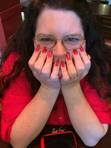Puzzling Away at Plotting

Erica Vetsch here with you today, and I am PLOTTING! Not global domination (although that would be sweet!) but rather a new story in my Thorndike and Swann Regency Mystery series. I'm mired in motives and means and opportunities for various people to look like the guilty party, as well as character arcs, theme, spiritual threads, subplots, research, and more.
Which got me to thinking about plotting a whole novel...and how it's a daunting task at the outset. You have all these bits and pieces and things that you know must be included, and that if you leave them out, the story won't be complete, and you panic a bit that you WILL leave something out and the story won't hold together, but you have to forge on because you have a deadline, and you WANT to write the story, but you can't until you have a plot...you get the drift of how my mind can kick into overdrive.
Whew! Deep breath.
There are several great analogies about plotting, and I'm going to use two here today.
First: Plotting is like a 5000 piece jigsaw puzzle.

So many pieces! So many shapes and colors, and you know they all fit together somehow, but when you first dump them out of the box, it's a jumbled mess! Just like all the plot ideas swirling in your head at the outset of the plotting.
How do you tackle this mountain of pieces?
1. Sort.
According to the picture on the box, you know there is a dog, a tree, a barn, a bunch of clouds, and a tractor. You cannot possibly work on all of those at the same time, so you begin sorting. Red barn pieces go in a pile, even though the pile doesn't yet make sense. Cloud pieces get their own spot on the table. And most importantly, the crucial edge pieces get pulled out.
The edge pieces are the basic framework of your plot. Begin with genre. Is this a romance? You will need a hero and a heroine. Is this a mystery? You'll need a detective and a crime. Is this coming-of-age story? You'll need a young protagonist.
Begin slotting together the edges of your story. The big decisions that will guide you in making the smaller decisions that are to come. Once you have the edges done, you can move on to the interior of the puzzle/story.
Gather the "like" pieces together. If the purple of the flowers only appears in that spot, all the purple pieces will go together eventually. This may represent your heroine. As a pile of purple flower pieces she's a mess, but one by one, you try, turn, slot and repeat until the image begins to appear.

Once you have those obvious things sorted...the characters you need for your story, you can move on to that big red barn or the mountainscape or whatever the focal point of your story is...the big picture! This is your main plot. What happens in the story. Start with the easy bits, say the door on the barn. What are the big story points you know will happen in your novel? If it's a romance, you know the boy and girl must meet, must have a plausible reason why they cannot fall in love, although they fall in love anyway, a moment when that love seems destined to never be, and a resolution. If you're writing a mystery, you need the crime, the introduction of the detective, the suspects, the clues, the blind paths that lead to nowhere and the final denouement.
Write down the big plot points on post it notes or note cards and lay them out in a logical order. Sort them like puzzle pieces. Fit, rotate, discard, and change until a picture of the story begins to emerge.
Then it's time to work on the more obscure parts of the plot puzzle. Things like subplots, themes, secondary characters, setting, mood. Take them one at a time, layering them into the story. Go back and readjust if necessary. Each time you fit in a piece of your plot puzzle, the entire picture become more filled in and recognizable.
Before you know it, you'll be slotting in the last piece that makes the story complete!
It's at this point, you're ready to type up a synopsis, but we'll save that for a later date...you've earned a celebration by getting this far in the process!
Oh, and I said there were two analogies I wanted to use to illustrate plotting a novel.
The second one is: How do you eat an elephant? One bite at a time.
It can be daunting when you begin plotting something as intricate and complex as an entire novel, but you can do it, just one bite at a time, one puzzle piece at a time!
Are you a plotter or do you fly by the seat of your pants?


Best-selling, award-winning author Erica Vetsch loves Jesus, history, romance, and sports. She’s a transplanted Kansan now living in Minnesota, and she is married to her total opposite and soul mate! When she’s not writing fiction, she’s planning her next trip to a history museum and cheering on her Kansas Jayhawks and New Zealand All Blacks. You can connect with her at her website, www.ericavetsch.com where you can read about her books and sign up for her newsletter, and you can find her online at https://www.facebook.com/EricaVetschAuthor/ where she spends way too much time!



